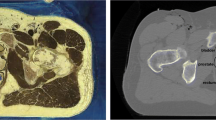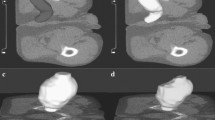Abstract
In the past decades, many machine learning techniques have been successfully developed and applied to the field of image-guided radiotherapy (IGRT). In this chapter, we will present some latest developments in the application of machine learning techniques to this field. In particular, we focus on the recently developed machine learning methods for delineating male pelvic structures for the treatment of prostate cancer. In the first few sections, we will present and discuss automatic and semiautomatic methods for CT prostate segmentation in the IGRT workflow. In the last section, we will present our extension of some recently developed machine learning approaches to segment the prostate in MR images.
Access this chapter
Tax calculation will be finalised at checkout
Purchases are for personal use only
Similar content being viewed by others
References
Weiss E, Hess CF. The impact of gross tumor volume (GTV) and clinical target volume (CTV) definition on the total accuracy in radiotherapy theoretical aspects and practical experiences. Strahlenther Onkol. 2003;179(1):21–30.
Brouwer CL, et al. 3D Variation in delineation of head and neck organs at risk. Radiat Oncol. 2012;7:32.
Sharp G, et al. Vision 20/20: perspectives on automated image segmentation for radiotherapy. Med Phys. 2014;41(5):050902.
Rohlfing T, et al. Quo vadis, atlas-based segmentation? In: Handbook of biomedical image analysis. USA: Springer; 2005. p. 435–86.
Heimann T, Meinzer HP. Statistical shape models for 3D medical image segmentation: a review. Med Image Anal. 2009;13(4):543–63.
Geremia E, et al. Spatial decision forests for MS lesion segmentation in multi-channel magnetic resonance images. Neuroimage. 2011;57(2):378–90.
Li W, et al. Learning image context for segmentation of the prostate in CT-guided radiotherapy. Phys Med Biol. 2012;57(5):1283–308.
Criminisi A, Shotton J, Konukoglu E. Decision forests: a unified framework for classification, regression, density estimation, manifold learning and semi-supervised learning. Found Trends Comput Graph Vis. 2012;7(2–3):81–227.
Shukla-Dave A, Hricak H. Role of MRI in prostate cancer detection. NMR Biomed. 2014;27(1):16–24.
Freedman D, et al. Model-based segmentation of medical imagery by matching distributions. IEEE Trans Med Imaging. 2005;24(3):281–92.
Costa MJ, et al. Automatic segmentation of bladder and prostate using coupled 3D deformable models. Med Image Comput Comput Assist Interv. 2007;10(Pt 1):252–60.
Foskey M, et al. Large deformation three-dimensional image registration in image-guided radiation therapy. Phys Med Biol. 2005;50(24):5869.
Chen S, Lovelock DM, Radke RJ. Segmenting the prostate and rectum in CT imagery using anatomical constraints. Med Image Anal. 2011;15(1):1–11.
Haas B, et al. Automatic segmentation of thoracic and pelvic CT images for radiotherapy planning using implicit anatomic knowledge and organ-specific segmentation strategies. Phys Med Biol. 2008;53(6):1751.
Ghosh P, Mitchell M. Segmentation of medical images using a genetic algorithm. In: Proceedings of the 8th annual conference on Genetic and evolutionary computation. Seattle:ACM; 2006. p. 1171–8.
Viola P, Jones MJ. Robust real-time face detection. Int J Comput Vis. 2004;57(2):137–54.
Zhan Y, Dewan M, Harder M, Krishnan A, Zhou XS. Robust automatic knee MR slice positioning through redundant and hierarchical anatomy detection. IEEE Trans Med Imaging. 2011;30(12):2087–100.
Zhan Y, Zhou XS, Peng Z, Krishnan A. Active Scheduling of Organ Detection and Segmentation in Whole-Body Medical Images. In: Metaxas D et al., editors. Medical Image Computing and Computer-Assisted Intervention – MICCAI 2008. Berlin/Heidelberg: Springer; 2008. p. 313–21.
Peng H, Fulmi L, Ding C. Feature selection based on mutual information criteria of max-dependency, max-relevance, and min-redundancy. IEEE Trans Pattern Anal Mach Intell. 2005;27(8):1226–38.
Zhang S, Zhan Y, Metaxas DN. Deformable segmentation via sparse representation and dictionary learning. Med Image Anal. 2012;16(7):1385–96.
Gao Y, Zhang Y, Shen D. Incremental learning with selective memory (ILSM): towards fast prostate localization for image guided radiotherapy. IEEE Trans Med Imaging. 2014;33(2):518–34.
Davis BC, et al. Automatic segmentation of intra-treatment CT images for adaptive radiation therapy of the prostate. Med Image Comput Comput Assist Interv. 2005;8(Pt 1):442–50.
Garrigues P, Olshausen B. Group sparse coding with a laplacian scale mixture prior. Adv Neural Inf Process Syst. 2010;23:1–9.
Krause A, Cevher V. Submodular dictionary selection for sparse representation. In: ICML 2010: proceedings of the 27th international conference on Machine learning. Haifa: Omnipress; 2010.
Aharon M, Elad M, Bruckstein A. K-SVD: an algorithm for designing overcomplete dictionaries for sparse representation. IEEE Trans Signal Process. 2006;54(11):4311–22.
Huang J, Yang M. Fast sparse representation with prototypes. In: Computer Vision and Pattern Recognition (CVPR), 2010 IEEE conference on. San Francisco, CA; 2010.
Jiang Z, Lin Z, Davis LS. Learning a discriminative dictionary for sparse coding via label consistent K-SVD. In: Computer Vision and Pattern Recognition (CVPR), 2011 IEEE conference on. Providence, RI; 2011.
Baraniuk R, et al. Applications of sparse representation and compressive sensing. Proc IEEE. 2010;98(6):906–9.
Wright J, et al. Robust face recognition via sparse representation. IEEE Trans Pattern Anal Mach Intell. 2009;31(2):210–27.
Elisseeff IGA. An introduction to variable and feature selection. J Mach Learn Res. 2003;3:1157–82.
Zou H, Hastie T. Regularization and variable selection via the Elastic Net. J Royal Stat Soc B. 2005;67:301–20.
Tu Z, Bai X. Auto-context and its application to high-level vision tasks and 3D brain image segmentation. IEEE Trans Pattern Anal Mach Intell. 2010;32(10):1744–57.
Dice LR. Measures of the amount of ecologic association between species. Ecology. 1945;26(3):297–302.
Warfield SK, Zou KH, Wells WM. Simultaneous truth and performance level estimation (STAPLE): an algorithm for the validation of image segmentation. IEEE Trans Med Imaging. 2004;23(7):903–21.
Coupé P, et al. Patch-based segmentation using expert priors: application to hippocampus and ventricle segmentation. Neuroimage. 2011;54(2):940–54.
Rousseau F, Habas PA, Studholme C. A supervised patch-based approach for human brain labeling. IEEE Trans Med Imaging. 2011;30(10):1852–62.
Liao S, Shen D. A learning based hierarchical framework for automatic prostate localization in CT images. In: Madabhushi A et al., editors. Prostate cancer imaging. Image analysis and image-guided interventions. Berlin/Heidelberg: Springer; 2011. p. 1–9.
Mallat SG. A theory for multiresolution signal decomposition: the wavelet representation. IEEE Trans Pattern Anal Mach Intell. 1989;11(7):674–93.
Dalal N, Triggs B. Histograms of oriented gradients for human detection. 2005.
Ojala T, Pietikainen M, Maenpaa T. Multiresolution gray-scale and rotation invariant texture classification with local binary patterns. IEEE Trans Pattern Anal Mach Intell. 2002;24(7):971–87.
Tibshirani R. Regression shrinkage and selection via the lasso: a retrospective. J Royal Stat Soc B Stat Methodol. 2011;73(3):273–82.
Belkin M, Niyogi P, Sindhwani V. Manifold regularization: a geometric framework for learning from labeled and unlabeled examples. J Mach Learn Res. 2006;7:2399–434.
Shi Y, et al. Transductive prostate segmentation for CT image guided radiotherapy. In: Wang F et al., editors. Machine learning in medical imaging. Berlin/Heidelberg: Springer; 2012. p. 1–9.
Tibshirani R, et al. Sparsity and smoothness via the fused lasso. J Royal Stat Soc B Stat Methodol. 2005;67(1):91–108.
Feng Q, et al. Segmenting CT prostate images using population and patient-specific statistics for radiotherapy. In: Proceedings of the sixth IEEE international conference on symposium on biomedical imaging: From Nano to Macro. Boston: IEEE Press; 2009. p. 282–5.
Jain A, Zongker D. Feature selection: evaluation, application, and small sample performance. IEEE Transactions Pattern Anal Mach Intell. 1997;19(2):153–8.
Bühlmann P. Bagging, boosting and ensemble methods. In: Gentle JE, Härdle WK, Mori Y, editors. Handbook of computational statistics. Berlin/Heidelberg: Springer; 2012. p. 985–1022.
Zhang S, et al. Towards robust and effective shape modeling: sparse shape composition. Med Image Anal. 2012;16(1):265–77.
Shen D, Ip HHS. A Hopfield neural network for adaptive image segmentation: an active surface paradigm. Pattern Recognit Lett. 1997;18(1):37–48.
Liao S, et al. Automatic prostate MR image segmentation with sparse label propagation and domain-specific manifold regularization. In: Gee J et al., editors. Information processing in medical imaging. Berlin/Heidelberg: Springer; 2013. p. 511–23.
Liao S, et al. Representation learning: a unified deep learning framework for automatic prostate MR segmentation. In: Mori K et al., editors. Medical image computing and computer-assisted intervention – MICCAI 2013. Berlin/Heidelberg: Springer; 2013. p. 254–61.
Kirschner M, Jung F, Wesarg S. Automatic prostate segmentation in MR images with a probabilistic active shape model. In: PRostate MR Image SEgmentation, PROMISE 2012. Nice: Electronic Publication; 2012. p. 28–35.
Maan B, van der Heijden F. Prostate MR image segmentation using 3D active appearance models. In: PRostate MR Image SEgmentation, PROMISE 2012. Nice: Electronic Publication; 2012. p. 44–51.
Martin S, Troccaz J, Daanen V. Automated segmentation of the prostate in 3D MR images using a probabilistic atlas and a spatially constrained deformable model. Med Phys. 2010;37(4):1579–90.
Birkbeck N, Zhang J, Zhou SK. Region-specific hierarchical segmentation of MR prostate using discriminative learning. In: The PRostate MR Image SEgmentation, PROMISE 2012. Nice: Electronic Publication; 2012.
Author information
Authors and Affiliations
Corresponding author
Editor information
Editors and Affiliations
Rights and permissions
Copyright information
© 2015 Springer International Publishing Switzerland
About this chapter
Cite this chapter
Gao, Y., Guo, Y., Shi, Y., Liao, S., Lian, J., Shen, D. (2015). Image-Guided Radiotherapy with Machine Learning. In: El Naqa, I., Li, R., Murphy, M. (eds) Machine Learning in Radiation Oncology. Springer, Cham. https://doi.org/10.1007/978-3-319-18305-3_9
Download citation
DOI: https://doi.org/10.1007/978-3-319-18305-3_9
Publisher Name: Springer, Cham
Print ISBN: 978-3-319-18304-6
Online ISBN: 978-3-319-18305-3
eBook Packages: MedicineMedicine (R0)




